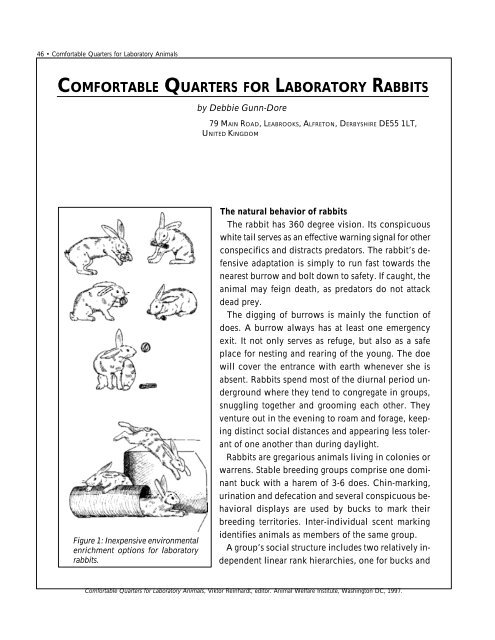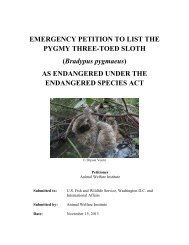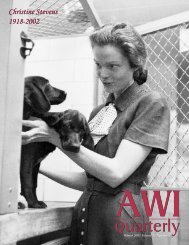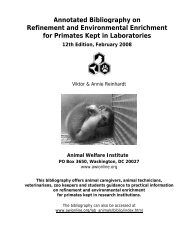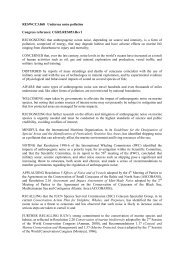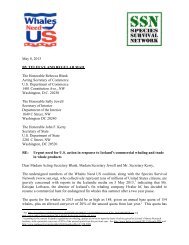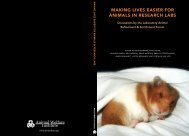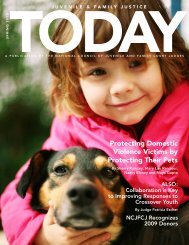comfortable quarters for laboratory rabbits - Animal Welfare Institute
comfortable quarters for laboratory rabbits - Animal Welfare Institute
comfortable quarters for laboratory rabbits - Animal Welfare Institute
You also want an ePaper? Increase the reach of your titles
YUMPU automatically turns print PDFs into web optimized ePapers that Google loves.
46 • Com<strong>for</strong>table Quarters <strong>for</strong> Laboratory <strong>Animal</strong>sCOMFORTABLE QUARTERS FOR LABORATORY RABBITSby Debbie Gunn-Dore79 MAIN ROAD, LEABROOKS, ALFRETON, DERBYSHIRE DE55 1LT,UNITED KINGDOMFigure 1: Inexpensive environmentalenrichment options <strong>for</strong> <strong>laboratory</strong><strong>rabbits</strong>.The natural behavior of <strong>rabbits</strong>The rabbit has 360 degree vision. Its conspicuouswhite tail serves as an effective warning signal <strong>for</strong> otherconspecifics and distracts predators. The rabbit’s defensiveadaptation is simply to run fast towards thenearest burrow and bolt down to safety. If caught, theanimal may feign death, as predators do not attackdead prey.The digging of burrows is mainly the function ofdoes. A burrow always has at least one emergencyexit. It not only serves as refuge, but also as a safeplace <strong>for</strong> nesting and rearing of the young. The doewill cover the entrance with earth whenever she isabsent. Rabbits spend most of the diurnal period undergroundwhere they tend to congregate in groups,snuggling together and grooming each other. Theyventure out in the evening to roam and <strong>for</strong>age, keepingdistinct social distances and appearing less tolerantof one another than during daylight.Rabbits are gregarious animals living in colonies orwarrens. Stable breeding groups comprise one dominantbuck with a harem of 3-6 does. Chin-marking,urination and defecation and several conspicuous behavioraldisplays are used by bucks to mark theirbreeding territories. Inter-individual scent markingidentifies animals as members of the same group.A group’s social structure includes two relatively independentlinear rank hierarchies, one <strong>for</strong> bucks andCom<strong>for</strong>table Quarters <strong>for</strong> Laboratory <strong>Animal</strong>s, Viktor Reinhardt, editor. <strong>Animal</strong> <strong>Welfare</strong> <strong>Institute</strong>, Washington DC, 1997.
Com<strong>for</strong>table Quarters <strong>for</strong> Laboratory Rabbits • 47the other <strong>for</strong> does. Bucks tend to distance themselves from each other, a strategy which effectivelyminimizes the chances of aggressive confrontations, whereas does stay close togetherbut may compete <strong>for</strong> burrows. Dominance-subordination relationships are fairly stable andfighting is generally a rare event. Low ranking <strong>rabbits</strong> are relatively restricted in their movementsand spend more time alone and concealed than high ranking group members.The domestication process has not altered the species-typical behavioral repertoire of <strong>rabbits</strong>.We there<strong>for</strong>e have an obligation to provide a species-adequate environment <strong>for</strong> <strong>laboratory</strong><strong>rabbits</strong> in order to guarantee their behavioral, psychological and physiological health andhence their general well-being.Laboratory <strong>rabbits</strong> housed in single cagesCurrent caging conditions <strong>for</strong> singly housed <strong>rabbits</strong> are designed to be hygienic with metal/plastic walls that are easy to clean. Free access to food and water guarantees that the occupant’sphysical needs are met. However, single caging deprives <strong>rabbits</strong> from contact with other conspecificsand the minimal floor space (76x60 cm [30x24 in.]) and height (45 cm [18 in.]) of thestandard cage severely restrict the animals’ freedom to carry out species-typical activities. Thebarren cage environment offers no stimulation. Even in terms of external visual stimulation,the barred front of the cage is partlyconcealed by the food hopper and bythe water bottle. Basic activities suchas <strong>for</strong>aging and digging and the exposureto variations in odors, texturesand diet are precluded.Some of the prominent activities ofsingle caged <strong>rabbits</strong> are behavior disorders.Such disorders substitute <strong>for</strong>biologically normal behaviors whichare inhibited due to a lack of elicitingstimuli. They include stereotypicalchewing/licking/biting of the bars, thegrid floor, the ceiling, the walls, thehopper and the water bottle, trichotillomania(hair-pulling and -eating), stereotypicalnose-sliding, head-swayingand pawing the cage walls, rearingup-spinning-around-and-falling-overand self-mutilation. The frequency andduration of such stereotypies signifi-NnBREEDING PEN (permanent structures)XtF = FeedingC = CentralP = PupX = IsolationFCBtPB = BeddedN = Nest boxn = nestt = tunnelFigure 2: Optimal arrangement of a breeding pen (drawingafter Stauffacher 1992).Nn
48 • Com<strong>for</strong>table Quarters <strong>for</strong> Laboratory <strong>Animal</strong>sFigure 3: Groups of does housed in adjacent floor pens with strawbedding and sturdy cardboard boxes.cantly increases with the durationof being confined in thebarren cage environment.Many of the single <strong>rabbits</strong>seem to be depressed, sittingin a hunched posture <strong>for</strong> hourson end, with little incentive toeven groom themselves. Suchanimals may have a staringcoat and dull eyes and, there<strong>for</strong>e,look unhealthy and maladaptedto confinement. Theextreme boredom and frustrationinduces some animals toovereat and others to undereatleading to obesity and severe and acute weight loss, respectively.If research protocols, such as metabolic studies, require that <strong>rabbits</strong> have to be singly caged,provision must be made that the animals are not visually isolated from other conspecifics andthat the cages are enriched to relieve boredom.Hay is an inexpensive yet effective substratum to promote the expression of natural behaviorsassociated with <strong>for</strong>aging, playing, investigating and nesting. It may also function as apreventive measure against ulcerative pododermatitis, typically occurring in wire-bottom cages.The hay has to be replaced every other day to avoid hygiene problems. Wooden sticks (e.g.,tree branches, old broomsticks) are also inexpensive and offer effective means to trigger species-typicalbehaviors such as gnawing, sniffing and chin-marking (Figure 1). The sticks shouldbe approximately 10 cm (4 in.) long with a diameter of 2.5 cm (1 in.). They have to be replacedregularly due to wear. Sturdy hollow wire balls (diameter 5 cm [2 in.]) entice caged<strong>rabbits</strong> to roll, kick and toss them and, when filled with pieces of carrots, encourage foodretrievingbehavior (Figure 1). The balls have the advantage over wooden sticks of being moredurable and easily autoclaved.Single animals who have access to hay, wooden sticks or wire balls show a reduction instereotypical behaviors and a marked increase in their overall activity. This indicates that theirbehavioral health is promoted by these simple environmental enhancers.Rabbits also require a den-like hiding area, to provide a refuge in alarming situations. Thearea beneath a side shelf or a PVC tube readily meet this requirement (Figure 1).Interconnecting two cages (“double” cage) is particularly beneficial because it offers thepossibility of social companionship.
Com<strong>for</strong>table Quarters <strong>for</strong> Laboratory Rabbits • 49Group <strong>for</strong>mation of <strong>laboratory</strong> <strong>rabbits</strong>Groups of unfamiliar immature <strong>rabbits</strong> of both sexes can be <strong>for</strong>med without undue risk ofinjury associated with aggression. Ideally, such groups should be established shortly afterweaning. Grouping siblings is advantageous over grouping unfamiliar animals since siblingsalready develop dominance relationships in non-injurious play-contests well be<strong>for</strong>e they reachthe age of weaning.Figure 4: Correct procedure <strong>for</strong> lifting andcarrying a rabbit.Individuals of a group can be recognized by distinctivecoat color/patterns, by marking them withwool dyes and xylene-free markers (requiring regularrenewal), or by implanted microchips.Group-housing <strong>rabbits</strong> that have been previouslysingle-caged <strong>for</strong> more than six months is not recommended.Such animals will be extremely fearful,will lack proper motor coordination resultingfrom long-term hypoactivity and will be prone toinjuries and fractures due to weaknesses in thebone structure. Pair-housing them in “double”cages minimizes these inherent risks while offeringa more species-adequate, i.e., social environment.Pair-housing, however, is only recommended<strong>for</strong> young animals and <strong>for</strong> adult females.Pair-housing of adult males is associated with seriousrisks of injurious aggression.Establishing groups of unfamiliar, sexually mature<strong>rabbits</strong> poses more of a problem than thegrouping of immature individuals. Grouping adultmales is not advisable—even if the animals arekin related—because of the insurmountable risksassociated with dominance and territorial antagonism.The animals will not establish and maintaina stable linear hierarchy, and the constant socialreorganization will be accompanied by intense,possibly injurious aggressive interactions. Evenyoung males who have been reared as a harmoniousgroup become incompatible when reachingsexual maturity and they will suffer distress if theyremain in close proximity with one another.Grouping adult females or adding strange rab-
50 • Com<strong>for</strong>table Quarters <strong>for</strong> Laboratory <strong>Animal</strong>sbits to an already established group of does can be rather risky but there are ways to minimizethese risks. The <strong>rabbits</strong> should not be introduced directly to each other, but future groupmembers should first be given the opportunity to familiarize with each other in a non-contactsituation. New animals should be placed in a cage within the group pen to allow mutualolfactory familiarization between the group members and the stranger(s).When <strong>for</strong>ming a new pair or group of does, separate cages/pens are recommended withtemporary wire-mesh partitions. This will allow the animals to establish dominance-subordinationrelationships without any risk of injury. The initial familiarization process may take 2-5 weeks. Partners are released thereafter into a structured, neutral double cage or pen, respectively.It may take an additional 1-3 weeks <strong>for</strong> the new companions to “settle down” and <strong>for</strong>mharmonious relationships with each other. Newly paired/grouped or re-paired/grouped doesmust be monitored closely <strong>for</strong> injuries and signs of maladaption (e.g., failure to eat/drink,weight loss, poor health, inactivity, reduced behavioral repertoire, hunched posture, constanthiding).Aggression (e.g., chasing, biting, attacking, socio-sexual mounting/circling, threatening,nudging) among paired or grouped adult does may occasionally result in minor injuries, suchas scratches and superficial bites. This is unavoidable, because confinement is a strong challenge<strong>for</strong> social relationships, with partners lacking sufficient space <strong>for</strong> adequate social distancingin situations of possi ble conflict. The animals may then resort to agonistic interactionsin an attempt to reconfirm or reorganize social dominance-subordination relationships.The effects of aggression can be alleviated by means of environmental manipulation, such asthe provision of hiding boxes, visual barriers and elevated shelves serving as escape routesand places to retreat.Individual animals who have to be separated from their companion(s) <strong>for</strong> any reason (e.g.,injury, non-infectious disease, treatment) should always be housed in such a way that they canmaintain visual and olfactory communication. This ensures that social relationships are notbroken and the temporarily separated individual is re-accepted by the other(s) without risk ofovert aggression.Laboratory <strong>rabbits</strong> housed in groupsHousing <strong>rabbits</strong> in compatible groups rather than in social isolation improves their mentaland behavioral health by eliminating the occurrence of stereotypies, while fostering the activeexpression of species-typical social behavior patterns. Housing <strong>rabbits</strong> in groups provides eachgroup member substantially more space and hence possibilities <strong>for</strong> exercise that the singlecaged rabbit lacks. Compatible group-housing does not significantly affect stress-sensitive variablesand infectious disease susceptibility when compared with single-housed <strong>rabbits</strong>.Until recently, group-housing was not considered an option because of perceived risks associatedwith aggression. Indeed, isosexual group-housing of adult male <strong>rabbits</strong> inevitably leads
Com<strong>for</strong>table Quarters <strong>for</strong> Laboratory Rabbits • 51to severe fighting, reflecting the biologicalintolerance of mature bucks.This aggression problem developsonly after the animals have reachedprepuberty, i.e., at 12-14 weeks ofage. Young males should there<strong>for</strong>ebe housed in a social environmentuntil this time, to allow them toexpress their inherent social nature.Keeping them in only-male groupsthereafter however, is only advisableif they are castrated, in orderto avoid aggressive intolerance.Adult female <strong>rabbits</strong> are sociallymuch more tolerant than males and,there<strong>for</strong>e, can and should be housed socially. Does actually prefer to be in the company ofanother conspecific in a pair-situation or with several conspecifics in a group-situation ratherthan living alone. Housing does in groups not only allows them to express their gregariousinclination but it also makes the animals less susceptible to stress than single-caged does. Formanagerial reasons, groups should not exceed ten animals.Figure 5: An adult rabbit is approximately 80 cm (31 in.) longwhen resting in typical rabbit-fashion, i.e., full lateral sternal recumbency.Rabbits develop rank relationships which are a prerequisite <strong>for</strong> a relatively harmonious grouplife. Removing or replacing adult group members inevitably disrupts and/or challenges theserelationships and may lead to serious aggressive disputes associated with the restructuring ofthe social hierarchy. Keeping the composition of a group stable is there<strong>for</strong>e very important.However, males and females should be separated permanently be<strong>for</strong>e they reach the age of10-12 weeks to avoid unwanted breeding.A well-structured environment with raised resting areas and tunnels is required to breed<strong>rabbits</strong> successfully. The pen should be divided into a central resting area, a feeding area anda bedded area (Figure 2). The bedded area should include 5-6 individual nest boxes. Theboxes should be designed in such a way that they shield littering females well from each otherto prevent infanticide (Figure 2). In addition, an isolation zone is useful to separate individualanimals if necessary with a wire mesh window. There should also be a pup-only quarter withan entrance that is too small <strong>for</strong> adults to pass through (Figure 2).Does will give birth every 30-33 days. In order to avoid overpopulation and the negativeconsequences associated with it, the offspring should be removed as soon as they becomeindependent (26-28 days of age) and transferred to rearing groups.Group-housed <strong>rabbits</strong> should be kept on a woodchip litter or preferentially on straw or
52 • Com<strong>for</strong>table Quarters <strong>for</strong> Laboratory <strong>Animal</strong>sFigure 6: An adult rabbit is about 75 cm (30 in.) tall whensitting in the rabbit-typical lookout position.shredded paper bedding (Figure 3).Hay must be provided <strong>for</strong> <strong>for</strong>agingand nest-building. The vertical dimensionof the enclosure should bemade accessible by means of shelves,providing preferred resting and hidingplaces. Wooden sticks and treebranches offer additional environmentalenhancement. Cardboardboxes, plastic crates and/or PVCtubes should be available as substituteburrows and “safe” places to retreatin fear provoking situations orduring social conflicts. Per<strong>for</strong>atingthe boxes and tubes increases the animals’feeling of security by allowingthem to keep visual contact with the “outside” world. The walls of the pen should consist ofwire mesh so that the animals can overlook their surroundings. This effectively eliminatesunnecessary alert- and fear-responses to approaching personnel.HandlingIf a rabbit has to be caught, she or he will usually run away and dart into one of the hidingplaces from where the animal may be readily picked up without struggling. This trick, however,works only if the rabbit does not associate the subsequent handling procedure withdiscom<strong>for</strong>t, anxiety or pain. It is crucial that <strong>rabbits</strong> are handled with gentle firmness andempathy to minimize discom<strong>for</strong>t and to avoid distress responses. Properly handled <strong>rabbits</strong>will come to the front of their enclosure when they hear familiar personnel. They will notretreat, but lie still when approached to be picked up. A rabbit should be held by the scruffand firmly supported under the hind legs, and carried with the head gently tucked under thehandler’s arm (Figure 4).Space recommendationsThe single cage must provide enough room so that the occupant can com<strong>for</strong>tably rest in fulllateral sternal recumbency. Taking into account that the outstretched length of the averageadult, 4-6 kg (8.8-13.2 lb.) heavy rabbit is approximately 80 cm (31 in.; Figure 5), the minimallength of the cage should be no less than 80 cm. To allow such an animal to com<strong>for</strong>tably turnaround and change postures, the cage should be 68 cm (27 in.) wide. The The minimum floorarea requirement <strong>for</strong> the single-caged, 4-6 kg adult rabbit is thus 0.54 m 2 (5.8 sq.ft.). Heavier
Com<strong>for</strong>table Quarters <strong>for</strong> Laboratory Rabbits • 53<strong>rabbits</strong> (>6 kg) require more space and have to be kept accordingly in larger cages.Pair-housed <strong>rabbits</strong> need twice the floor space of the single-housed rabbit. The “double”cage should be at least 120 cm (48 in.) wide.The minimum height of the rabbit cage should be 60 cm (24 in.) to enable the occupants toat least sit up with their ears erect. A height of 75 cm (30 in.), however, would be moreappropriate and hence is recommended because it allows the animals to sit up on their hindlegs in the typical lookout posture (Figure 6).If more than two adult <strong>rabbits</strong> of the weight category 4-6 kg are housed together in a pen, theminimum floor area should be 2 m 2 (22 sq.ft.) <strong>for</strong> up to four animals, increasing by 0.45 m 2 (4.8sq.ft.) <strong>for</strong> each additional rabbit. Abreeding group of 2-5 does, one buckand one generation of their offspringshould be allocated a floor area of 9m 2 (97 sq.ft.).The height of group pens should be120 cm (47 in.) or more (dependingon the height of boxes/shelves) to preventthe occupants from leaping out.SummaryThe traditional standard-sized singlecages currently used <strong>for</strong> housing <strong>rabbits</strong>are inadequate to satisfy the animals’behavioral and physiologicalneeds. Group housing arrangements,preferably in well-structured floorpens with straw bedding and individualnest boxes can overcome theseshortcomings. Group-housed <strong>rabbits</strong>express a considerably enhanced behavioralrepertoire compared with singlycaged <strong>rabbits</strong>. They are truly <strong>rabbits</strong>,because they can hop, leap, situp on the hind legs in rabbit-fashion,hide in “burrows,” <strong>for</strong>age with otherconspecifics, groom each other (Figure7) and sham-burrow in the substratumbe<strong>for</strong>e lying down.Figure 7: Species-typical social grooming patterns in<strong>laboratory</strong> <strong>rabbits</strong>.
54 • Com<strong>for</strong>table Quarters <strong>for</strong> Laboratory <strong>Animal</strong>sIn situations where a rabbit has to be caged alone, access to a refuge area and objects <strong>for</strong>gnawing and playing should be provided. A single caged rabbit must never be kept in socialisolation but should always be able to have visual and possibly also olfactory contact withother <strong>rabbits</strong>.AcknowledgementI wish to thank Prof. D.B. Morton <strong>for</strong> his comments and support, and the Department ofBiomedical Science and Ethics, The Medical School, The University of Birmingham <strong>for</strong> theirhelp and funding of this work.Suggested further readingBatchelor GR 1991. Group housing on floor pens and environmental enrichment in SandyLop <strong>rabbits</strong>. <strong>Animal</strong> Technology 42, 109-120.Brooks DL, Huls W, Leamon C, Thomson J, Parker J, Twomey S 1993. Cage enrichment <strong>for</strong>female New Zealand White <strong>rabbits</strong>. Laboratory <strong>Animal</strong>s 22, 30-35.Gunn D 1994. Evaluation on <strong>Welfare</strong> in the Husbandry of Laboratory <strong>rabbits</strong>. DoctoralDissertation: University of Birmingham.Gunn D, Morton DB 1993. The behaviour of single-caged and group-housed <strong>laboratory</strong><strong>rabbits</strong>. Proceedings of the 5th Federation of European Laboratory <strong>Animal</strong> Science AssociationsSymposium, pp 80-84.Gunn D, Morton DB 1995. Inventory of the behaviour of New Zealand White <strong>rabbits</strong> incages. Applied <strong>Animal</strong> Behaviour Science 45, 277-292.Huls WL, Brooks DL, Bean-Knudsen D 1991. Response of adult New Zealand White <strong>rabbits</strong>to enrichment objects and paired housing. Laboratory <strong>Animal</strong> Science 41, 609-612.Love JA, Hammond K 1991. Group housing <strong>rabbits</strong>. Laboratory <strong>Animal</strong>s 20, 37-43.Morton DB, Jennings M, Batchelor GR, Bell D, Birke L, Davies K, Eveleigh JR, Gunn D,Heath M, Howard B, Koder P, Phillips J, Poole T, Sainsbury AW, Sales GD, Smith DJA,Stauffacher M, Turner RJ 1993 Refinements in rabbit husbandry. Second report of the BVAAWF/FRAME/RSPCA/UFAW joint working group on refinement. Laboratory <strong>Animal</strong>s 27, 301-329.Podberscek AL, Blackshaw JK, Beattie AW 1991a The behaviour of group penned and individualcaged <strong>laboratory</strong> <strong>rabbits</strong>. Applied <strong>Animal</strong> Behaviour Science 28, 353-356.Podberscek Al, Blackshaw JK, Beattie AW 1991b. The effects of repeated handling by familiarand unfamiliar people on <strong>rabbits</strong> in individual cages and group pens. Applied <strong>Animal</strong>Behaviour Science 28, 365-373.Stauffacher M 1992. Group housing and enrichment cages <strong>for</strong> breeding, fattening and <strong>laboratory</strong><strong>rabbits</strong>. <strong>Animal</strong> <strong>Welfare</strong> 1, 105-125.Whary M, Peper R, Borkowski GF et al. 1993. The effects of group housing on the researchuse of the <strong>laboratory</strong> rabbit. Laboratory <strong>Animal</strong>s 27, 330-341.


